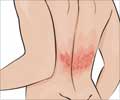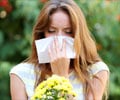Pollen Grains
Pollens are released from the male flowers of flowering plants and their size varies from 10-100 microns. They are tiny, granular male reproductive cells found in the flowering plants. Some species are self-pollinating wherein pollination takes place in the same flower. In others, pollen has to be transferred from one plant to another for fertilization to take place. This is known as cross-pollination and one of the medium of transportation of pollens is the wind.
The airborne pollens are small, light and dry in texture, as a result are easily carried by the wind across small or large distance. For example, ragweed (Ambrosia artemisiifolia) pollen may travel as far as 400 miles and as high as 2 miles in the air. Airborne pollens are produced in large numbers by the plant as most of the pollens are lost in transit (owing to contact with some insect , animal or human body) and do not reach their target. Pollens which directly or indirectly come in contact with human bodies are the major source of allergic reactions.
Note that all airborne pollens do not cause seasonal allergic reactions. For example, pine tree pollens are heavy, so they usually fall straight to the ground and do not float in the air. So, they are not much of a allergy causing source. Similarly, pollens from plants with large flowers or bright and colorful flowers rarely cause hay fever. The types of pollen that most commonly cause allergic reactions are produced by the plain-looking plants (trees, grasses, and weeds) that do not have prominent flowers.
One of the most obvious feature of pollen allergy is its seasonal nature. Each plant has a pollinating period. Exactly when a plant starts to pollinate depends on the relative length of night and day and on geographical location. Thus, the farther north you go, the later is the plant’s pollinating period and the later is the allergy season. Pollen count (represents the concentration of the pollen in the air in a certain area at a specific period of time) tends to be highest on warm, dry, breezy days and lowest during chilly, wet periods.
Here’s a list of plants whose pollens are the source of pollen allergy:
- Trees: Ash, birch, acacia, cottonwood, walnut, oak, maple, elm, cypress, box elder and hickory in the US. In India, common sources of pollen allergy in this category are Ailanthus excelsa (tree of heaven or Mahanimb), Azadirachta indica (neem), Madhuca indica (mahua), Mimusops elengi (bakula), Morus alba (white mulberry), Eucalyptus spp, Cassia spp. and Murraya paniculata (orange jasmine, kamini).
- Grass: Bermuda grass, rye, wild oat, orchard, Sorghum (Johnson grass, fodder grass), Pennisetum (pearl millet).
- Weeds: Parthenium, Amaranthus, Argemone mexicana (prickly poppy), Prosopis julifera (kikar), ragweed, pigweed, cocklebur, sagebrush, marsh elder and tumbleweed.


















